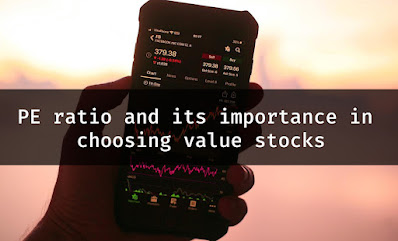In share market trading, various strategies and
tools are used to analyze stocks and estimate their future growth. P/E ratio
(Price-to-Earnings Ratio) is one of the most frequently used methods which is
used for comparing stocks against either market standards or other stocks in
the same sector. The formula for calculating the P/E ratio is the current stock
price (P) divided by earnings-per-share (E). The current stock price is the
price that the investor has to pay for a stock, while the earnings-per-share is
the ratio of the company’s profit to the total number of company shares.
P/E ratio allows investors to make apple-to-apple
comparisons. In essence, the P/E ratio indicates the amount an investor is
willing to pay for one rupee of the company’s earnings. For example, in
the year 2020, the stock price of JPMorgan Chase and Co. (JPM) was $127.07 and
earnings-per-stock was $8.88 resulting in the P/E ratio being 14.31. This means
that the investors are willing to pay $14.31 for $1 of the company’s profits.
The P/E ratio is an important indicator to identify
under-valued stocks (value stocks). Value investing involves strategies to
identify and invest in stocks that are intrinsically under-valued, also called
value stocks. Stocks are often under-valued when the majority of the investors
in the market underestimate their potential hence resulting in the stock price
not reflecting the true potential of the business/company. The proponents of
value investing, along with multiple other markers, use the P/E ratio to
understand whether a stock is over or undervalued.
There are different methods of calculating the P/E
ratio, though the crux of the formula remains the same, the time frame can be
modified to gain varied perspectives. The most commonly used P/E ratio is the
trailing P/E ratio which considers the past 12-month earnings-per-share.
Businesses have cyclic tendencies and to mitigate its impact on the P/E ratio,
investors often use P/E 10 or P/E 30 which uses the company’s historical data
of 10 or 30 years respectively.
Conversely, the forward P/E ratio uses the
estimated projected earnings of the business or forecasts by external analysts.
This draws a clear picture of the future and enables in comparing the past and
future ratios of the same company.
Considering the above example of JPM, it might not
be sufficient to draw sufficient insights. Hence, investors often use the P/E
ratio to compare companies in the same sector or industry group to draw
benchmarks and understand whether a company is over or undervalued. For
instance, the stock price of Bank of America, around the same time, was $30.31
and ESP was $1.87. This results in the P/E ratio being 16.21.
The higher P/E ratio of Bank of America than JPM
indicates that the investors are expecting a higher growth at Bank of America
in the near future.
The primary limitation of the P/E ratio is that
companies might have a varying growth rate and timelines of earning money;
hence it is not completely analogous for comparison. Also, while calculating
the forward P/E ratio, the projected earnings are often adjusted by companies
to show growth in the next business cycle. Different companies have different
accounting which can also affect the comparison. Another limitation of the P/E
ratio is that it cannot be calculated for new stocks and is marked as not
available (N/A).
P/E ratio is a commonly used metric by investors
that is effective for comparing stocks but one needs to be mindful of the
limitations.






.jpg)
0 Comments